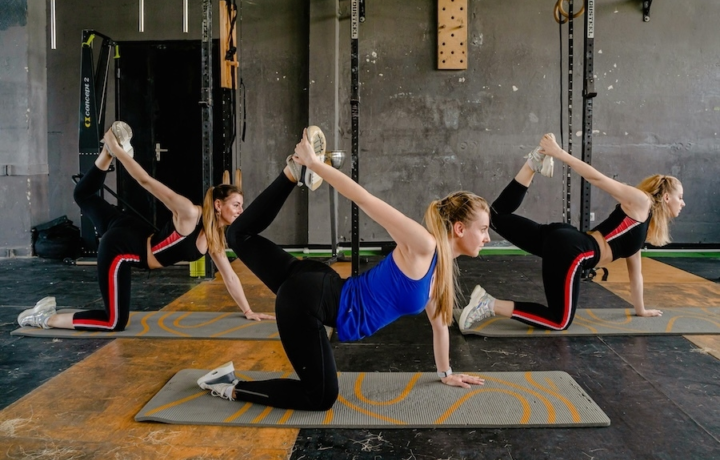Exercise
Standing Hip Flexor Stretch

Standing Hip Flexor Stretch
How to Perform
- Stand upright with your feet hip-width apart, maintaining a neutral spine and engaged core.
- Take a large step backward with your right foot, keeping your front left foot flat on the ground.
- Bend your front knee to create a 90-degree angle while keeping your back leg straight, allowing your back heel to lift naturally.
- Square your hips forward and gently tuck your pelvis under (posterior pelvic tilt) to intensify the stretch in the front of your right hip.
- Maintain an upright torso position, avoiding leaning forward or arching your lower back as you exhale slowly.
- For added stability, place your hands on your hips or rest them gently on your front thigh.
- Hold this position for 20-30 seconds while breathing deeply, feeling the stretch in the hip flexor of your back leg.
- Return to the starting position and repeat on the opposite side by stepping back with your left foot.
Important information
- Keep your front knee tracking over your ankle, not extending past your toes, to protect your knee joint.
- Maintain your torso upright throughout the stretch; avoid the common mistake of leaning forward which reduces the effectiveness of the hip flexor stretch.
- If you feel any pinching in the front of your hip, adjust by slightly reducing the depth of your stance or decreasing the posterior pelvic tilt.
- For a deeper stretch, you can raise your arm on the same side as your back leg straight overhead while maintaining proper alignment.

Standing Hip Flexor Stretch
Exercise Details
Primary Muscles
Mechanic
Built for progress
Take the guesswork out of training
Create personalized AI-powered workout plans that evolve with you. Train smarter, track every rep and keep moving forward, one workout at a time.






The Standing Hip Flexor Stretch offers a simple yet effective way to release tension in the front of your hips, an area that often tightens due to prolonged sitting or intense physical activity. This beginner-friendly stretch targets the hip flexor muscles—primarily the iliopsoas and rectus femoris—which play crucial roles in everyday movements like walking and climbing stairs.
When incorporated into your recovery routine, this stretch helps alleviate the stiffness that accumulates after workouts, particularly following lower-body training sessions. The gentle lengthening of these muscles promotes better circulation to the area, facilitating faster recovery and reduced soreness. Many fitness enthusiasts find this stretch equally valuable as part of their cool-down ritual, helping the body transition from high-intensity exercise back to a resting state.
As a warm-up element, the Standing Hip Flexor Stretch prepares your hips for movement by increasing blood flow and temporarily improving range of motion before you tackle more demanding activities. This preparation is especially beneficial before exercises that require hip extension, such as lunges, squats, or running.
Beyond its immediate benefits, regular practice of this stretch contributes to enhanced mobility throughout the hip complex. The modern lifestyle, characterized by extended periods of sitting, often leads to chronically shortened hip flexors, which can contribute to postural issues and lower back discomfort. By consistently stretching these muscles, you work toward restoring proper length-tension relationships in the hip region.
The beauty of this stretch lies in its accessibility—it requires no equipment and minimal space, making it perfect for a quick mobility break during your workday or as part of a more comprehensive stretching routine. While seemingly simple, the Standing Hip Flexor Stretch delivers significant benefits for everyday movement quality and athletic performance when performed regularly with proper attention to form and breathing.
FAQ - Standing Hip Flexor Stretch
Hold the stretch for 20-30 seconds per side, focusing on deep breathing throughout. For chronic tightness, you may benefit from 2-3 sets per side with a slight increase in duration as your flexibility improves.
This stretch primarily targets the iliopsoas (deep hip flexor) and rectus femoris (part of your quadriceps). Secondarily, it can also affect the tensor fasciae latae and parts of your lower abdominals when performed correctly.
Yes, but with modifications. Keep your stance wider for stability, don't lunge as deeply, and consider placing your hand on a wall or chair for support. If you feel any knee pain during the stretch, reduce the intensity or consult a physical therapist for alternatives.
The most common errors include using too much hand pressure, elevating your shoulders toward your ears, and rotating the head instead of purely side-bending. Keep your shoulders relaxed and focus on a gentle lateral movement without forcing the stretch.
For general maintenance, perform this stretch 2-3 times per week. If you sit for long periods or have noticeably tight hips, daily stretching for 1-2 minutes per side can significantly improve mobility and may help reduce lower back discomfort.

